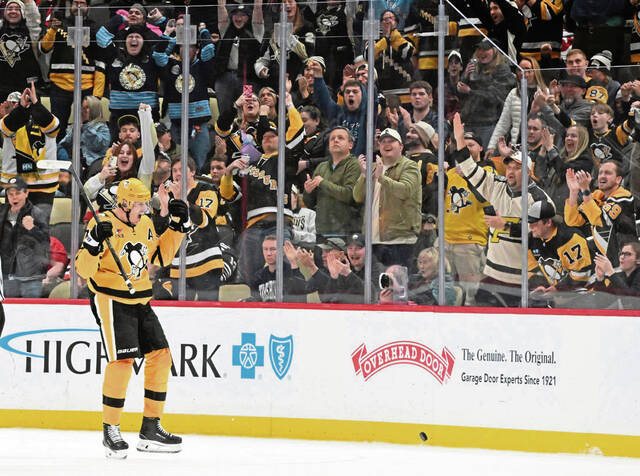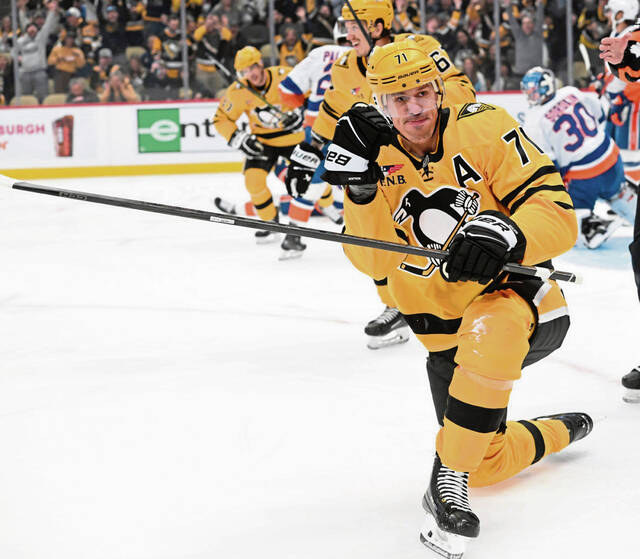A lie detector test would be in order for anyone claiming to have predicted that at this increasingly late juncture of the season, an inability to score enough goals would be the Pittsburgh Penguins’ Achilles’ heel.
From afar, as the Penguins got underway in October, inconsistent goaltending, struggles on the blue line and/or injury woes seemed far likelier sources of trouble.
And yet, here the club is, fighting desperately to stay afloat in the playoff race, and it’s mainly because of its offensive issues. The power play, which ranks 29th in the NHL with a 14.6% success rate, has been an ongoing problem.
Sooner or later, the Penguins are sure to feel the impact of top wingers Jake Guentzel and Bryan Rust being out of the lineup because of injury.
But even before they went down, the Penguins had struggled to score consistently.
Sunday’s six-goal outburst against Philadelphia propelled the Penguins slightly up the NHL leaderboard in goals per game, but they still are averaging less than three (2.95), which ranks 22nd leaguewide.
A major discrepancy that has confounded coach Mike Sullivan pertains to analytical expected goals vs. actual goals scored.
Particularly, it’s been the juxtaposition between the former, which ranks ninth in the NHL, and the latter, which is 20th, in 5-on-5 scenarios.
Per Natural Stat Trick, the Penguins have netted 118 goals 5-on-5, but their expected goals on the year are 128.97.
“There’s been a lot of positive things with our underlying numbers,” Sullivan said. “At the end of the day, we understand that the actuals are the most important, and that’s where we’ve got to try to reconcile the difference. There’s no easy answer for that.”
Expected goals are calculated by taking into account a team’s shots and assigning value to each based on a number of factors to calculate the probability that it results in a goal.
Shot location, such as near the crease or in the slot, is a major component, as are situational details, like when a shot comes on the power play or 5-on-5.
Sullivan realizes the results have not been good enough. That said, Sullivan has been pleased with the looks the Penguins are creating.
“When you look at analytics, and we look at an awful lot of it, a lot of it is supposed to measure the process,” he said. “It’s supposed to tease out some of the things that you can’t control. For example, you can’t control whether the puck goes in the net or it doesn’t, but what you can control is your opportunity to create scoring chances, and that reflects in an expected goals model.
“So a lot of those types of numbers, their intent is to codify or present a picture of that process and what it looks like. It’s a different conversation if you’re not getting scoring chances.”
If the Penguins’ 5-on-5 “actuals,” to use Sullivan’s term, compared to expected goals have been cause for concern, the club’s analytics vs. real results on the power play presents even more of a head-scratcher.
The Penguins have scored 25 goals on the traditional 5-on-4 power play, which is 25th in the NHL.
But in terms of expected power play goals, the Penguins rank fifth in the league with 42.75.
In total, at all strengths, the Penguins have managed 29.31 goals less than expected.
Those missed opportunities loom large for a club that has dropped 16 games this season by one goal.
So are the Penguins routinely getting good looks and chances but simply failing to finish?
That could be part of the puzzle.
Alternate captain and power-play regular Kris Letang hesitated to put a large amount of stock into the analytics.
“If we would have buried all the chances, we would not be talking about it right now,” Letang said. “It’s a whole. The finish, execution, staying the course, don’t get frustrated — there’s a lot of components there to take into account here. These are just stats on a sheet of paper. It means nothing.”
Whatever has plagued the Penguins on the power play so far this year, forward Rickard Rakell couldn’t quite put his finger on it.
“I wish I had an answer,” Rakell said. “I would be the first guy to change something.”
Sullivan repeatedly has complimented Lars Eller’s hockey IQ this season, noting how well the 34-year-old center sees and plays the game.
The cerebral Eller recently offered a different diagnosis of the power play’s woes.
“I think it’s more all the things we’re doing maybe prior to getting the shot or the chance,” he said. “It’s more execution of the breakouts and the passes in the zone that we weren’t in sync (on) as units. That’s how I would describe it.”
For the Penguins, figuring out a way to close the gap and have their expected goals more closely reflect actual goals remains a work in progress.
Time for discovering a solution is running out.
But Sullivan remains optimistic on what the advanced analytics are telling him.
“I think our players are doing a really good job as far as creating opportunities to score,” Sullivan said. “I believe if we continue to do that, then results will follow.”








